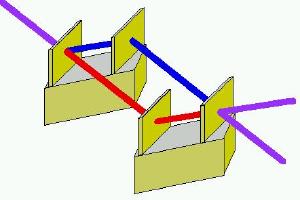Multi-Crystal Interferometry with Intensity Correlation
1. Why multi-crystal interferometer?
And it's difficulty.
 Monolithic
Laue-Laue-Laue Interferometer
Monolithic
Laue-Laue-Laue Interferometer
In general interferometers require a stability of wavelength. This
means X-ray interferometers need Angstrom stability.
It is the strigent requirement why most researchers have made X-ray interferometers
in a monolithic scheme.
 Skew-symmetric
triple Laue bicrystal Interferometer
Skew-symmetric
triple Laue bicrystal Interferometer
Interferometers made from separate crystals have many
possibilities.
1. One can scan only one component of the
interferometer, such as the analyzer for lattice constant measurements.
2. One can obtain wider interference area
for phase contrast imaging, than that limited by the size of Si ingot in
case of monolithic interferometers.
3. One can get larger separation in the interferometer,
where variable optics may be inserted.
But the strigent requirement of Angstrom
stability and resolution.
2. Visibility and Intensity
Correlation.
Suppose the output intensity, I, from the interferometer is exppressed
as
 ,
,
where <I> is the average intensity, V is the visibility of the
intensity oscillation, and phi is the phase variable. Its auto correlation
is given by
 .
.
Since phi is related to the angstrom scale, phi
scans over wide range during measurements if special care was
not take to stabilize the interferometer. Thus averaging by phi, one get  , and
, and  .
.
Now measuring intensity correlation (auto correlation), the
visibility of the oscillation can be decided by
 .
.
3. Experimental Verification
of Theory.
 Left figure
is a schematic setup of the experiment. First two crystals were beam expander.
Next two crystals consited the skew-symmetric LLL bicrystal interferometer.
Each block was mounted on independent precision goniometer, and their separation
was 500 mm.
Left figure
is a schematic setup of the experiment. First two crystals were beam expander.
Next two crystals consited the skew-symmetric LLL bicrystal interferometer.
Each block was mounted on independent precision goniometer, and their separation
was 500 mm.
The experminetal setup @ BL29XUL

4. Result and Discussion
to be written
 Monolithic
Laue-Laue-Laue Interferometer
Monolithic
Laue-Laue-Laue Interferometer
 Skew-symmetric
triple Laue bicrystal Interferometer
Skew-symmetric
triple Laue bicrystal Interferometer
 .
.
 Left figure
is a schematic setup of the experiment. First two crystals were beam expander.
Next two crystals consited the skew-symmetric LLL bicrystal interferometer.
Each block was mounted on independent precision goniometer, and their separation
was 500 mm.
Left figure
is a schematic setup of the experiment. First two crystals were beam expander.
Next two crystals consited the skew-symmetric LLL bicrystal interferometer.
Each block was mounted on independent precision goniometer, and their separation
was 500 mm.